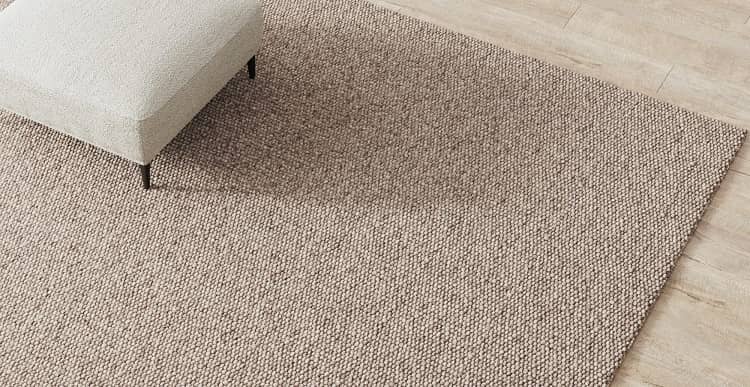The wool rug is one of the most common types of rugs in America.
Its appeal, durability, and warmth make it a popular choice for homeowners who want to add comfort to their homes. One downside of owning a wool rug is that they are not always easy to clean. When you have time on your hands, you can get down on your hands and knees with some soap, water, and a scrubbing brush to scrub away dirt from the fibers.
But what do you do when you need an instant cleaning solution?
We’ll discuss this topic in-depth below.
How Often to Clean a Wool Rug
If your wool rug is in good condition and given enough exposure to sunlight, it may only need cleaning every three years. It also depends on how much foot traffic the area gets as well as where it’s placed.
For instance, if you have a wool rug by the front door that everyone walks over but rarely opens their shoes upon entry, then you’ll want to clean this more often than a small dining room corner rug under which guests typically do not walk or take off their shoes before entering.
Also, consider what type of flooring you have underneath since some floors can be easily damaged from too-frequent washing with harsh chemicals. In contrast, others are virtually indestructible no matter what products they’re exposed to.
How to Clean a Wool Rug Yourself
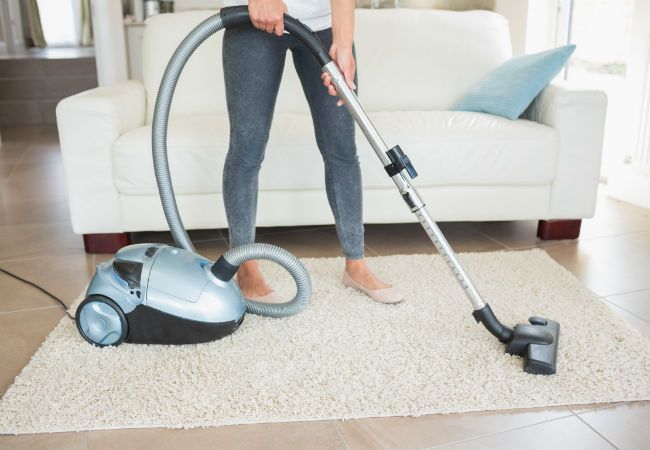
Determine What Type of Pile You Have
If your rug is less than three years old or has had its fibers replaced, you can safely clean it yourself.
When cleaning a wool rug by hand, the first step is determining what type of pile style your rug falls under.
There are two main categories: cut and looped.
- Cut piles are made from short individual strands that have been sheared then tied together into one continuous length, while looped rugs are composed of many twisted filaments which form loops when woven together. Each type requires different care during vacuuming as well as dry-cleaning if necessary later down the line so take note before continuing with this process. For these types of rugs, only use manual or machine vacuuming to avoid damaging or pulling out the fibers.
- Looped piles – If you have a loop pile type rug, it’s very important not to use any kind of beater bar on your vacuum as this can damage and destroy the loops causing shedding, which will ruin your entire cleaning efforts. Instead, opt for using only manual vacuuming with plenty of elbow grease at first, then follow up by giving it an extra deep clean through steam-cleaning, which uses hot water mixed with detergent instead of just plain tap water like dry-cleaning does.
Just remember that if you don’t know what type of wool rug you own, then always assume that it’s made from cut piles, so proceed accordingly throughout every step before continuing with any additional processes.
Give it an Old Fashioned Beating
Your first step should be to beat the rug as much as you can with a stick. This does two things: it helps loosen up dirt, dust, and debris on your wool rug’s surface and fluffs up the fibers, making them more receptive to absorbing water. If you have an old broom or mop that has had its bristles removed, use it instead.
Vacuum it
Now that you’ve determined what type of pile your rug has, it’s time to vacuum.
For cut piles, be sure not to use any rotating brush on the bottom of your machine since these can cause damage, so instead just do single-pass strokes until you have removed all visible dirt, followed by a second round where you’ll go over each area once more in forward and backward motions.
Related Reading: The Best Vacuum Cleaners for Area Rugs.
For looped rugs, though with their extra thick, dense texture, opt for using just manual vacuuming at first, then proceed to steam cleaning only if absolutely necessary, but again this is up to personal preference based on how worn or dirty your rug looks after this step.
Shake it Out
Now it’s time to shake out your rug to remove any excess dirt particles that were loosened by either vacuuming or steaming. Using a stiff-bristled brush, slowly pass over the entire surface in long back and forth motions followed by another round of lighter fluid for stubborn stains, then finish off once more with manual vacuuming just like before.
Dry Powder
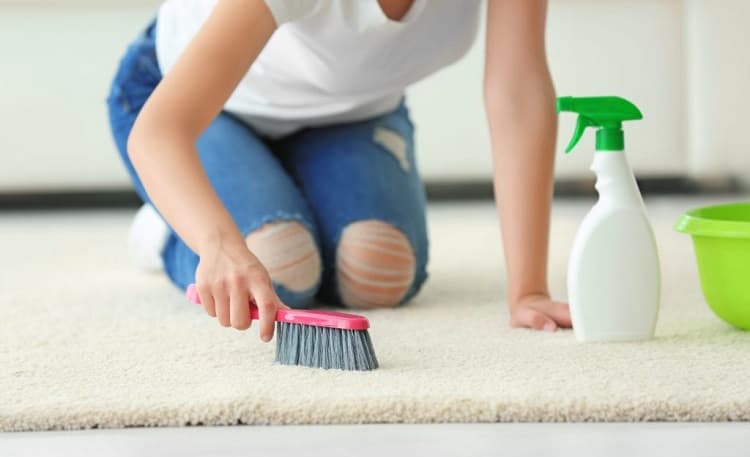
Of course, you can also use a wet sponge to clean your wool rug. But the problem with this is that it’s really difficult for dry powders and sponges to absorb liquid from damp or wet rugs. That means they have a hard time absorbing water from the fibers, which in turn makes them less efficient at cleaning up dried-on stains.
You can use a vacuum cleaner to suck up the dry powder, but be sure it has no bristles so as not to damage your wool rug. However, remember that you should never place your hand inside any kind of appliance while it’s running.
You shouldn’t use certain chemicals on rugs because they actually dissolve dyes and cause discoloration. For example, you should avoid using oxygen-based bleaches since these will break down some of the fibers in your wool rug, leading over time to more wear and tear. Instead, opt for non-chlorine bleach, which is much gentler with fabrics like yours.
Snow Dusting
Snow dusting is a technique that you can use to clean particularly dirty spots on your wool rug. Snow Dusting involves using an ice cube and then rubbing it over particular spots that need cleaning. The coldness of the ice makes stains more visible, so they become easier for you to spot and subsequently handle.
The cubes should be used sparingly because if too many are applied directly onto one area, this might cause some damage to the fibers in your wool rug or even lead them to develop small holes. The snow-dusted areas should not be allowed to dry out while being exposed either, as this will also result in thinning fibers after time.
Afterward, just remember there’s no need to go through all these steps every single day since rugs should only be vacuumed or beaten once a week. Doing these things more often can actually result in you wearing out the fibers faster than they would naturally.
Finally, if your rug does get wet, then never place it up against an air conditioner as this will cause damage to its fibers over time which might lead them to break and fray – rendering your wool rug completely unusable. The best thing is to allow it to dry at room temperature.
Steam Cleaning
Steam cleaning is another method you can use to clean your wool rug. This involves using hot steam vapor that comes out of a machine that goes deep into the fibers to remove dirt, dust, and stains.
When choosing this method, your best bet should be with professional cleaners since they’re used specifically for rugs like yours and have special equipment to dry out wool rug quickly.
Rotate Your Rug
If you have a large wool rug, it’s essential that you rotate this at least once per month to even out the wear and tear. If one side becomes more worn than another, then your carpet will begin to develop unsightly bald patches, which are difficult for any kind of machine to get rid of.
However, there is no need for concern because rotating just requires some time on your part, but not much effort either since all you’ll be doing is simply turning the thing over from end to end each month or so. This way, both sides receive equal amounts of sunlight throughout their lifetime, prolonging their lifespan significantly.
Use baking soda with vinegar
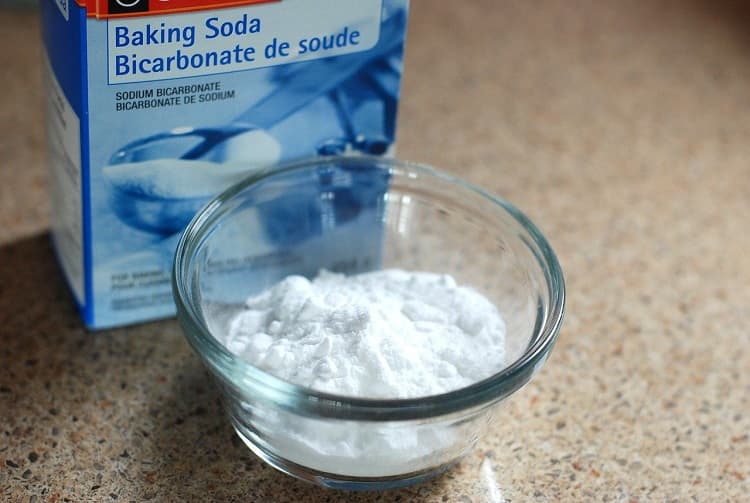
If you want to clean your wool rug, then this is a simple step-by-step guide that makes it easy.
First of all, mix some water and vinegar together in equal parts before applying baking soda with either an old toothbrush or cotton swab on top of the stain. This should be left to sit for about 30 minutes before scrubbing vigorously over the area where needed to get rid of any unwanted dirt.
Once completed, just rinse off thoroughly using more water until no remnants are visible, at which point everything can simply be dried naturally without having to use anything else whatsoever.
Related Reading: How to Clean Your Rug with Baking Soda.
This technique works well because not only does it keep colors fresh but also leaves behind a pleasant fragrance too, thanks to its natural ingredients like lemon juice used within the solution. However, this can surely be substituted with other items like salt, Borax, or even vodka if you don’t have any vinegar on hand.
Finally, remember that whichever solution you choose should always be tested first in a non-visible area before applying anywhere else just to ensure it doesn’t cause your wool rug any damage whatsoever.
Use vinegar with water
Vinegar is also another good choice for cleaning your wool rug. It’s an excellent alternative to harsher chemicals which can be particularly harmful if not used correctly, and vinegar has many other benefits too.
For instance, it helps remove the smell of mildew that might accumulate on your carpet over time because this acts as a disinfectant killing mold spores before they have the chance to spread their odor far and wide across your home. This way, you’ll find yourself spending less money on deodorizers while keeping things safe at the same time since drinking water isn’t recommended when diluted with these chemicals either.
However, white vinegar should never be combined with baking soda; otherwise, this will produce toxic fumes, so just keep them separate until ready to use.
Also, remember that vinegar is extremely acidic, so it’s important to clean your wool rug with this solution sparingly since over-exposure might lead the fibers to become increasingly damaged. Once finished, just rinse everything off using water until no signs of either are present, at which point you can then let things dry naturally without having anything else being required in the process.
Use chamomile tea bags
Chamomile tea has been used for centuries to dye fabric and wool or even keep them fresh if they’re already dyed – this is because it’s a natural way of preserving the color.
This same effect can be achieved when using chamomile bags as well, which should always come in organic form so as not to contain any pesticides. Therefore place these over your carpet before vacuuming up all loose debris afterward, but remember that rugs shouldn’t be vacuumed directly onto one area as this might cause some damage from fibers being pulled out too soon.
Once finished, leave everything sitting overnight until completely dry. After this point, you’ll find yourself with a clean rug that smells wonderful at the end of the day since chamomile is also known to act as an effective deodorizer. Remember that you will need at least two bags per square foot of space for this method to work properly.
Use shampoo for your rug
Another simple way of cleaning your wool rug is to use shampoo.
This works best for removing dirt and dust rather than stains, but you can also add baking soda or salt to make it more effective if needed.
Simply mix the solution together before applying over any areas which are visibly dirty where necessary. After this point, they should be left alone until all foam has been absorbed into the fibers, at which point things will need to be vacuumed up thoroughly afterward, too.
Just rinse everything off with water once finished to remove any excess soap and dry completely using a fan afterward so as not to cause damage from mold spores growing inside while allowing fabric fibers time enough to recover back their original texture and shape gradually over time instead.
Keep this method in mind next time you have guests coming over so you can keep your wool rug looking perfect for any occasion.
Make your own rug cleaning shampoo at home
A great way of making a rug shampoo at home is to use baking soda and vinegar.
Mix them together in equal parts for an effective cleaning agent that will leave your carpets smelling fresh. You can also add some dish soap or baby shampoo into the mixture if you’d like, although this isn’t necessary when using only these two ingredients before applying over any areas which are visibly dirty where necessary.
Once finished, just rinse everything off with water once all foam has been absorbed, allowing fabric fibers time enough to recover back their original texture gradually while ensuring it doesn’t cause further damage instead while leaving any residue behind either.
Professional Cleaning
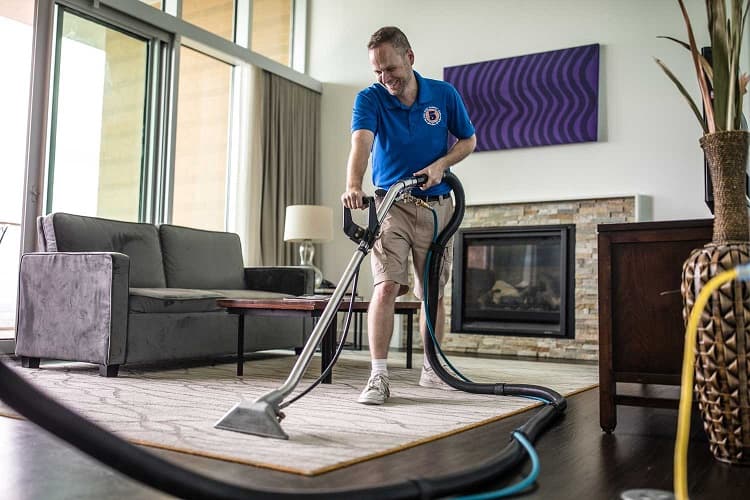
If you’re not able to clean your wool rug yourself, then the best thing to do is bring it in for professional cleaning.
Many companies offer such a service and will be more than happy to help with anything you might need when getting rid of stains or old odors from fabrics, rugs, and upholstery.
These services tend to cost anywhere between $50-100 depending on size. So remember this before bringing in any very large carpets if possible, especially since they’ll mostly only use hot water, which can cause damage when used excessively by itself without proper detergent or vacuum afterward when drying things out completely too.
Just keep these tips in mind next time you find yourself needing assistance, ensuring that your carpet remains looking brand new no matter what the situation might be.
Remove Stains
Removing Red Wine Stains
If you ever happen to spill red wine onto your wool rug, then there are a few things that can be done about it.
First of all, don’t try to scrub the area because this will only cause further damage leaving behind permanent stains which won’t come off no matter what.
Instead, just lightly rub over any affected areas using some water before dabbing dry with a towel or paper towels if necessary. You can also use hydrogen peroxide for removing stubborn stains, although keep in mind that this isn’t always effective either, so try not to get too upset when nothing works right away since these kinds of solutions aren’t miracle workers at times after all, even though they’re still able to do their job well without causing additional harm afterward as long as used properly.
Removing Pet Stains
If you have a dog or cat and they’ve made any messes on your wool rug, then you’ll need to use some other methods to remove pet stains from carpets.
- Mix up a solution of mild shampoo and cold water. Soak the affected area with this mixture using a sponge or cloth. Let it sit for five to ten minutes before you start scrubbing gently.
- Next, use a clean cloth to soak up the solution and sponge away any excess.
- If your rug is made of wool, then it’s important that you do not scrub too hard or use hot water as this will damage the fibers in your fabric. It might be wise to take it into a professional cleaner if you have stubborn stains on an expensive piece.
Related Reading: The Best Pet-Friendly Rugs.
Removing Tomato Sauce Stains
This is one of the trickiest substances to remove from any kind of fabric, including your wool rug.
The best thing you can do when getting rid of tomato sauce stains on carpets or rugs comes down to using water because it’s able to break up not only that substance but also grease too.
So if possible, just pour a generous amount over the top, coating everything evenly before allowing enough time for materials beneath to absorb all fluid completely without leaving anything behind afterward no matter how much has been used either, although remember that some older spots might take longer than others, so be patient during the entire process instead and allow things plenty of additional time being left alone for cleaning solutions below have an opportunity working their magic as well making sure nothing remains behind afterward.
Removing Coffee Stains
Coffee stains are just as difficult to remove from your wool rug as anything else mentioned before, so you should continue following the same process as explained earlier for it all to work effectively.
The best thing about coffee stains is that they can be easily removed with a little bit of dish soap and water, which doesn’t take very long either if applied correctly.
Just make sure not to scrub harshly because this will only cause further damage. Rather dab gently using a soft cloth or paper towels instead while also making sure no one comes into contact with any leftover residue.
Then give those parts underneath another quick rinse eliminating any remaining particles afterward before drying completely without leaving anything behind on your wool rug either if possible.
Removing Makeup, Ink and Nail Polish Stains
If your wool rug has any makeup, ink or nail polish stains on it, then you’ll need to use a few different solutions to remove them without much effort.
Apply ice cubes over the top, allowing those particles below enough time to work their magic while also cooling down affected areas as well keeping everything safe by avoiding burns or other damage.
Then dab with a clean cloth or paper towels using dish soap and water to finish off the process completely without leaving anything behind on your wool rug either.
Different Types of Wool Rugs and Cleaning Tips
Cleaning Fine Wool Rugs
Fine wool rugs are made from a soft and delicate material, so they’re able to absorb stains easily and come with their own cleaning process specifically designed for them.
For you not to do any damage or cause further issues, it’s best if the first thing you do before trying anything else at all comes down to always making sure your fine wool rug doesn’t get wet because this will ruin it completely.
So make use of a hairdryer on its lowest setting in order to blow away dust particles while also removing some excess moisture beneath instead without having anyone actually touch those areas until after everything has already dried completely afterward.
Then you can start using professional-grade cleaners carefully, avoiding hard scrubbing motions that might push things deeper down into the pile instead of simply removing them by hand, which is much safer and doesn’t pose a threat either.
You can also try using a vacuum cleaner on its lowest setting to suck up larger particles before finishing off with another quick blow from your hairdryer in order for everything you’ve done so far not to be completely ruined afterward.
Regular Wool Rug Care and Cleaning Tips
Regular wool rugs don’t require nearly as much attention and maintenance like fine ones do, which is why they’re great for families with kids.
In fact, children love to play around with regular wool rugs without having to worry about things like spelling or staining them because this doesn’t really happen very often in the first place, especially when used properly.
You can also try using a vacuum cleaner on its lowest setting, but never above it unless there’s no other way left to remove anything, which doesn’t happen too often either.
Regular wool rugs are also suitable for larger spaces, so you can place them almost anywhere without having to worry about using special cleaners at home whenever possible.
Do Not Steam Clean Wool Rugs
For all of you who were hoping to use your steam cleaner on top of these kinds without having to worry about anything, sorry but that’s not possible.
Steaming wool rugs is actually very dangerous because this will cause them to shrink and get ruined completely, which is why it should never be done at home ever.
Plus, the only areas where moisture might come in contact with are also difficult ones, so instead, try using professional-grade cleaners or dry clean everything once every couple of months for maintenance purposes whenever needed.
And remember: always avoid scrubbing motions while cleaning any kind of wool rug since they can snag easily, causing damage over time unless there’s no other way left available afterward.
How to Keep a Wool Rug Clean
Keep your wool rug clean by trying to avoid it getting any stains in the first place whenever possible.
This will make things much easier for you when it all comes down to actually giving them a nice cleaning afterward.
However, if something does get spilled on top of yours, then always try using dry towels or napkins until nothing is left behind anymore because this could cause damage over time instead of making sure everything looks great again afterward without having to worry about anything at all.
NOT Try to Bypass Professional Cleaning
If you are not experienced with this type of cleaning, hiring professionals for the job is better. Home-made solutions don’t work well in most cases and can damage your valuable rugs even more than they already are (after all, these substances include dangerous chemicals).
NEVER get your wool rug soaking wet
Never get your wool rug soaking wet. The same goes for steaming and dry cleaning them at home (even if you opt for the DIY route). Professionals use specialized machines that ensure no water is left in any of the rugs’ fibers, so there won’t be a problem shrinking or damaging it due to moisture.
Protect your rug with a mat or runner
Before you clean your rug, place a pad or runner underneath it. This will ensure that no water penetrates the floor beneath and facilitates easier cleaning afterward (you don’t want to scrub off any of the dirt stuck in between fibers).
FAQ
How Should I Clean New Wool Carpets?
To clean new wool carpets, it is recommended that you first vacuum the rug several times to remove loose dirt. Then mix one part water with two parts of mild detergent (liquid) and use a soft brush or sponge on the area until suds appear. Squeeze out any excess moisture from your cleaning solution by pressing down firmly with a towel; do not scrub as this will damage the fibers in your carpet, causing them to mat together, which can cause balding areas over time.
- You should only dry clean if food stains are present since home cleaners may make these worse instead of better.
- Do not wet the entire carpet; otherwise, it could leave behind an undesirable smell or result in mold growth.
- If you have a wool carpet, then wet clean with water by first vacuuming, mixing detergent into water and scrubbing lightly. Do dry this off immediately afterward so mold doesn’t grow.
How Do I Perform Regular Cleaning and Maintenance?
Vacuum the rug at least once a week and more frequently if possible. Make sure to remove all of the dirt from it by lifting each corner and using a small brush for hard-to-reach areas.
Related Reading: The Best Rugs for High-Traffic Areas.
How Do I Perform an Annual Cleaning?
The first thing you need to do is vacuum the rug one more time. Then, take water and a mild detergent in a small bowl, mix them well until they are foamy.
Take the mixture of water with detergent on your hands or just use it as it is if there isn’t too much dirt on your carpet. If you have any delicate areas that shouldn’t be scrubbed with an aggressive cleaning solution, make sure to cover those places first. Use only gentle motions when washing these parts of the fabric so as not to ruin their texture or dyeing pattern.
Afterward, dry off all parts of the rug using paper towels or cloths depending on what kind of material it has been made of.
Final Thoughts on Cleaning Wool Carpeting
Wool is a very durable and resilient fabric that can stand up to a lot of wear and tear. That’s why it will require special care to not damage the fibers or fade colors over time.
In conclusion, both annual and regular maintenance procedures are important for keeping your home clean while preserving each item’s original appearance as much as possible.

